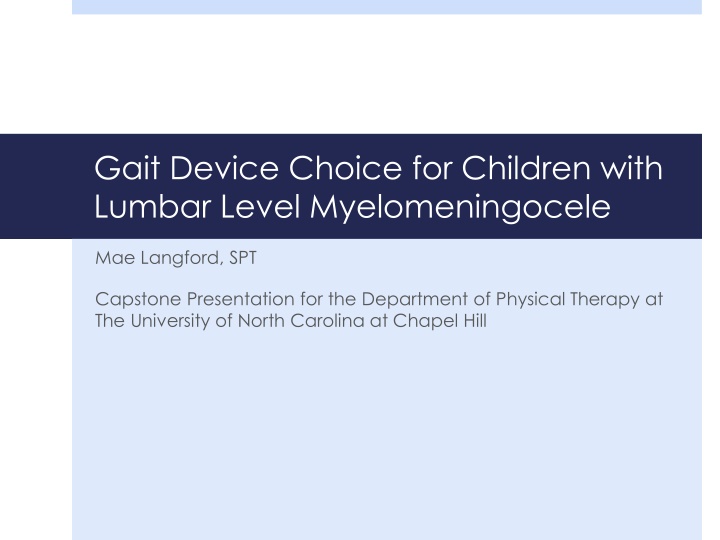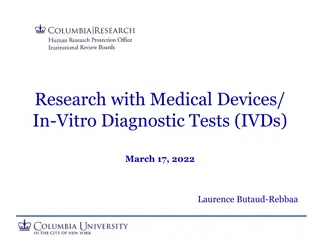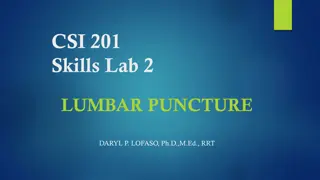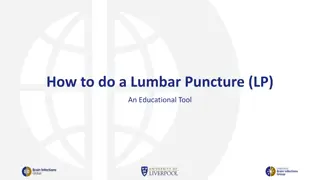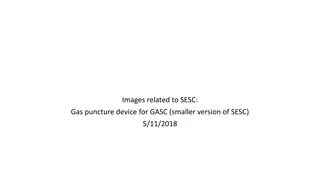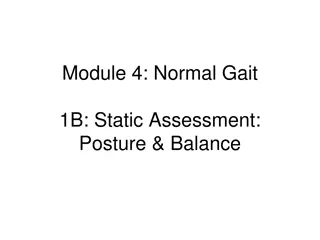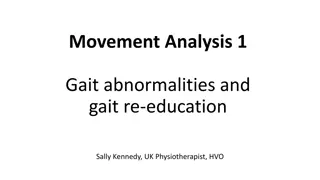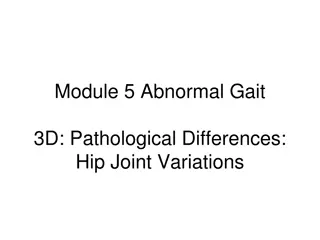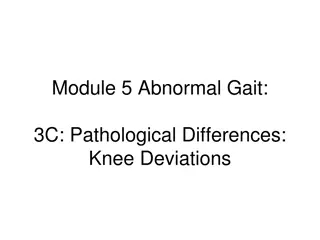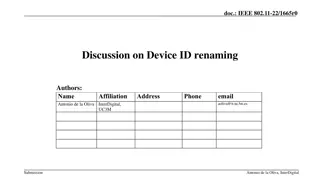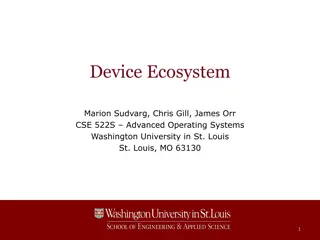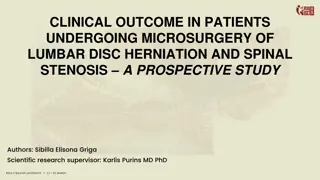Gait Device Selection for Children with Lumbar Level Myelomeningocele
This presentation discusses the considerations and choices of gait devices for children with lumbar level myelomeningocele. It covers the specific needs of pediatric patients, benefits and drawbacks of various devices, funding requirements, and clinical application through case studies. The material explores why children and adults may require assistive devices for gait, how children differ from adults in mobility considerations, and how these differences influence the selection of assistive devices. Different types of gait devices such as gait trainers, support walkers, and wide-based steel frames are highlighted.
Download Presentation

Please find below an Image/Link to download the presentation.
The content on the website is provided AS IS for your information and personal use only. It may not be sold, licensed, or shared on other websites without obtaining consent from the author.If you encounter any issues during the download, it is possible that the publisher has removed the file from their server.
You are allowed to download the files provided on this website for personal or commercial use, subject to the condition that they are used lawfully. All files are the property of their respective owners.
The content on the website is provided AS IS for your information and personal use only. It may not be sold, licensed, or shared on other websites without obtaining consent from the author.
E N D
Presentation Transcript
Gait Device Choice for Children with Lumbar Level Myelomeningocele Mae Langford, SPT Capstone Presentation for the Department of Physical Therapy at The University of North Carolina at Chapel Hill
Learning Objectives Following the the presentation the learner will: Understand why gait devices are chosen for children Understand considerations that are specific to pediatric device choice Recognize the benefits and drawbacks of various gait devices Be familiar with funding requirements for pediatric gait devices Understand the state of the literature on choosing a device for children with lumbar level myelomeningocele Be able to demonstrate clinical application of the materials through completion of case studies
Lets Review Why do children and adults need assistive devices?
Why do people of any age need assistive devices for gait?1 Stability/Balance/Safety Weight bearing precautions Energy Conservation/Fatigue Excessive skeletal loading Cosmesis Pain
How are children little adults and how are they different in regards to mobility considerations?1,2 Children Adults -Growing -Need to participate in the classroom/keep up with peers -Families must be considered - Impairments/abilities may change with age -Not growing -May be living independently -Impairments may be static -More variety in job requirements -Stability -WB precautions -Fatigue -Pain -Alignment
How does our choice of AD change because of those differences?2,3 Must consider Diagnosis and literature available Level of impairment Age and size of the child Participation at home and school Cost and funding sources Ease of modification Parent and child preference
Kinds of gait devices Gait Trainer/Support Walker Wide-based steel frame5 Walker Adjustable aluminum frame1 Used for balance/support4 Four wheels5 Child is able to bear weight4 Considerable postural support- including trunk forearm or pelvic support 3,5 Covered by Medicaid without prior approval5 Device and accessories require prior Medicaid approval and may be covered for patients 0-20yo5 Available in heavy duty size based on height and weight5
Letter of Medical Necessity Gait Trainer/Support Walkers Maximal support for walking because of impaired balance, pelvic or trunk instability, or scores 3 on GMFCS5 Walker Has mobility limitation that impairs toileting, feeding, dressing, grooming and bathing5 Able to safely use the device5 Able to independently initiate movement with a purposeful need for the movement5 Functional mobility deficit is adequately resolved with the device5 Must justify all components5
Medicaid Reimbursement5 Device Life Expectancy 2 years (age 0-20) 3 years (age 21- ) Wheeled or pick-up walker, light frame Heavy Duty walker with or without wheels Replacement handgrips and tips walker Pediatric gait trainer and all accessories 3 years (all ages) 6mo (age 0-20) 1 year (age 21- ) 3 years (age 0-20 only)
Who do we typically use assistive devices for? Pediatric PTs report commonly using supportive walkers for children with cerebral palsy (CP), Developmental Delay, Spina Bifida, spinal cord injury and pediatric orthopedic disorders.3 Anthem Blue Cross Blue Shield considers pediatric gait trainers medically necessary for children with spinal cord or brain injury, CP, neuromuscular disease, or spina bifida when they require moderate-maximum support for ambulation.6
What do Pediatric PTs look at when choosing an assistive device?3 Weakness, motor control, balance, posture, tone, gait pattern, cognitive status, ROM Hip development, cardiorespiratory status, bone density, peripheral circulation, pressure relief, GI function, renal function
What do Pediatric PTs use when deciding between devices?3 Clinical assessment, time a patient will be able to use the device, evidence, funding, ease of adjustment, access to type of walker and vendors supply of walker (in order of importance) Family s preference, ability to adjust and maintain the walker, child s preference, financial resources Study results were unclear regarding why a walker was placed anteriorly or posteriorly.
When choosing a device Allow for trial time to ensure the correct device has been chosen.3 Monitor the child ambulating on various surfaces in their environment.2 Reassess the device at every visit to determine if changes need to be made.3
Lets look at how to apply this information to a population Children with lumbar myelomeningocele are often provided with assistive devices for gait.2,5,3,6
Spina Bifida Myelomeningocele (MMC), also called spina bifida is a subset of a broader group of congenital malformations of the neural tube called Myelodysplasia. 2,5 The motor level of the lesion is assigned based on functional muscles. 2 Other impairments that can occur with MMC include reduced sensation, hydrocephalus, altered brain development, tethered cord, spasticity, osteoporosis and obesity. 2,7
Spina Bifida Cont. The variety of impairments throughout the body secondary to myelomeningocele can limit an individual s ability to participate in school, limit socialization and participation in age- appropriate activities and reduce quality of life. 2 Mobility is important to improve cardiorespiratory fitness, reduce obesity, allow access to the surrounding environment and to allow for participation in daily activities. 2,8
Mobility by Level of Lesion1 Lesion Level L1-L2 Motor Function Mobility Expectation -Weak hip musculature -Hip flexion and adduction contractures common -Strong hip flexion and adduction -Weak hip rotation and knee extension - Medial hamstrings or anterior tibialis grade 3/5 -Short distance mobility with KAFOs or RGOs and an assistive device -WC for community distances -KAFOs and gait assistive device for short distances, WC for long distances L3 L4 -AFOs or KAFOs and a gait assistive device for short distances, WC for long distances -Many stop ambulating after growth -Orthoses for alignment -Gait assistive device for long distances -WC for very long distances or rapid growth L5 - Lateral Hamstrings 3/5 AND gluteus minimus and medius 2/5, posterior tibialis 3/5 or peroneus tertius 4/5
Gait characteristics of children with lumbar level myelomeningocele A higher level of spinal involvement results in increased compensatory motions9 Children with lumbar MMC often develop knee flexion contractures resulting in a crouched gait secondary to weak hip and knee extensors10 The variety in presentation of strength and weakness means people with the same spinal level involvement will not always achieve the same functional level. Ambulation for children with MMC has a high energy cost, requiring greater O2 consumption than typically developing children.8,10,11
What does the literature say about assistive devices? The research is largely old and based on children with cerebral palsy.2 Posterior rolling walkers and gait trainers have been recommended for children with spina bifida based on cerebral palsy research that indicates posterior walkers facilitate a more upright posture.2 To date, there are no articles that directly analyze the use of anterior verses posterior rolling walkers for children with spina bifida.
If there is no research, what do you do? It depends In order to determine the appropriate assistive device for these children, you must try different options. Looks are not everything! A posterior walker may facilitate an upright posture BUT these children have motor deficits below the level of their spinal involvement. Forward progression requires compensatory movements in the trunk and upper extremities.9 If the device does not allow for momentum, gait may be less efficient.
Feasibility of Wheelchair and Biped Ambulation: Criteria for Evaluation2 Household Distances -Adequate to go between rooms in house? -Adequate to get to yard and car? Community distances - Sufficient at a functional speed for average community distances? -Adequate for play and recreational activities? -Adequate for long-distance community activities? -Record HR and calculate energy expenditure -Record normal and fast walking paces. -Adequate speed to cross intersections? -Is typical pace practical for community distances? Endurance -Record HR and calculate energy expenditure -Record normal and fast household walking speeds -Is fast pace adequate for emergency situations? -Is normal pace practical for everyday activities? Efficiency Chart found in Physical Therapy for Children Fourth Edition, pg. 730
Household Distances Cont. -Independent with all transfers -Able to carry, lift, reach and climb -Able to perform activities of daily living -Able to go forward, backward, sideways and turn Community Distances Cont. -Independent in all transfers -Able to maneuver in all directions -Able to climb and step over obstacles -Able to carry groceries -Able to reach and lift items from shelves -Has good stability and balance -Observes joint and skin protection -Able to maneuver around obstacles and congested areas -Safe on uneven terrain, wet or slippery surfaces, curbs, inclines, and steps Effectiveness -Has good stability and balance -Observes joint and skin protection -Able to maneuver around obstacles -Safe on smooth surfaces and rugs -Safe when turning -Maneuvers in and out of the house independently -Necessary household rooms accessible -Emergency routes accessible Safety -Maneuvers in and out of car and bus independently -Necessary community buildings accessible Accessibility Chart found in Physical Therapy for Children Fourth Edition, pg. 730
Characteristics to consider What does the child need to be able to do at home and at school? Do they have enough energy to complete academic work after walking? How much support do they need? Can they do those things in a way that provides maximum opportunity for participation in age appropriate activities? If ambulation is not efficient enough with the current assistive device, you must consider alternative wheeled mobility. While ambulation is important for exercise and weight management, functional mobility without overexertion is vital! (may even need to consider power mobility)
With age, mobility will likely change for this population As patients age, their mobility changes. A child may begin with a walker but move to lofstrand crutches with improved balance.2 Later in life, walking cessation may occur14 Rapid growth and weight gain during puberty alters the body s mechanics A change in bracing or equipment need without prompt acquisition can alter ambulatory ability Spinal cord tethering could alter the neurological deficit and result in the child becoming more involved Increased distance demands with life changes may require more endurance
Lets practice making some of these decisions.
Checking in on Darrius Update: Darrius is now 11 years old and will be entering middle school soon. When he ambulates, he uses bilateral HKAFOs and a posterior rolling walker. As he has grown taller and heavier, forward progression has become more labored. Darrius has begun to complain of pain with shoulder extension during his recent PT sessions. Darrius has a wheelchair that was ordered for long distances at school and in the community but more often, he chooses to ride instead of walk for shorter distances. Darrius s mom is concerned that Darrius is not walking like the other children at school. She is also worried because at Darrius s most recent appointment, the primary care physician suggested a weight loss program to manage his excess weight. It is time to make a decision about Darrius s next mobility device.
Carrie History: Carrie is a 5-year-old with L4/5 myelomeningocele. She was born with mild hydrocephalus and was successfully shunted using a VP shunt. Carrie began ambulating at age 3 and was prescribed a posterior SnugSeat Crocodile without additional attachments. With the increased upper extremity support, Carrie was able to ambulate independently. Carrie s PT ordered twister cables to address her mild in-toeing and KAFO s for stability and protection as she learned to ambulate.
Carrie Continued Carrie has now begun kindergarten at the local elementary and is using KAFOs and her posterior crocodile for all school mobility. While mildly cognitively involved secondary to hydrocephalus, Carrie is able to participate in a normal classroom setting. She is beginning to learn to self- catheterize and is an active participant in the classroom. Recently, Carrie s teacher has reported that Carrie seems to forget to bring her walker with her when transitioning between stations in the classroom. Carrie will walk for 3-5 feet before losing her balance and either falling or reaching for furniture to catch herself. The most recent fall has created an abrasion on the front of her right shin that has been slow to heal. Concerned about Carrie s safety, the teacher has asked the school physical therapist to think of a way to keep her from falling. At this time, Medicaid will cover a new device so the school therapist would like to make a change to Carrie s mobility device.
Thank you for your time! Please contact me with any questions. mae_langford@med.unc.edu
References 1. O'Sullivan, Susan B. Schmitz, Thomas J Fulk, George D, ed. Physical rehabilitation. 6th ed. F.A. Davis Company; 2014. 2. Campbell SK, Orlin M, Palisano RJ, eds. Physical therapy for children. Fourth ed. St. Louis, Mo.: Elsevier/Saunders; 2012. 3. Low SA, McCoy SW, Beling J, Adams J. Pediatric physical therapists' use of support walkers for children with disabilities: A nationwide survey. Pediatric physical therapy. 2011(23):381-389. 4. Noble E. Medicaid reimbursement making the case for a gait trainer. Rifton.com Web site. http://www.rifton.com/adaptive-mobility-blog/blog-posts/2011/october/pediatric-walkers- medicaid-funding. Published October 18, 2011. Updated 2011. Accessed 02/07, 2015. 5. North Carolina Division of Medical Assistance. Durable medical equipment and supplies. Medicaid and Health Choice Clinical Coverage Policy No: 5A. 2013:1-115. Anthem Blue Cross Blue Shield. Clinical UM guideline: Pediatric gait trainer. Anthem Web site. 6. Anthem Blue Cross Blue Shield. Clinical UM guideline: Pediatric gait trainer. Anthem Web site. http://www.anthem.com/medicalpolicies/guidelines/gl_pw_c174202.htm. Updated 2014. Accessed 02/22, 2015. Shaer CM. The infant and young child with spina bifida: Major medical concerns. Infants and young children. 1997;9(3):13. 7. Darbee JC, Franks CA, Palisano RJ. The effect of walking with an assistive device and using a wheelchair on school performance in students with myelomeningocele. Phys Ther. 1991;71(8):570.
References 8. Ounpuu S, Thomson JD, Davis RB, DeLuca PA. An examination of the knee function during gait in children with myelomeningocele. Journal of Pediatric Orthopaedics. 2000;20(5):629-635. 9. Moen T. Crouched gait in myelomeningocele A comparison between the degree of knee flexion contracture in the clinical examination and during gait. Journal of pediatric orthopaedics. 2005;25(5): 657-660. 10. Bartonek A, Saraste H. Factors influencing ambulation in myelomeningocele: A cross-sectional study. Dev Med Child Neurol. 2001;43(4):253-260. 11. Bare A, Vankoski SJ, Dias L, Danduran M, Boas S. Independent ambulators with high sacral myelomeningocele: The relation between walking kinematics and energy consumption. Dev Med Child Neurol. 2001;43(1):16-21. 12. Lephart K, Utsey C, Wild DL, Fisher SR. Estimating energy expenditure for different assistive devices in the school setting. Pediatric physical therapy. 2014;26(3): 354-359. 13. David KS, Sullivan M. Expectations for walking speeds: Standards for students in elementary schools. Pediatric physical therapy. 2005;17:120-127. 14. Williams EN, Broughton NS, Menelaus MB. Age-related walking in children with spina bifida. Dev Med Child Neurol. 1999;41(7):446-449.
